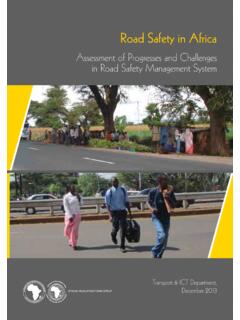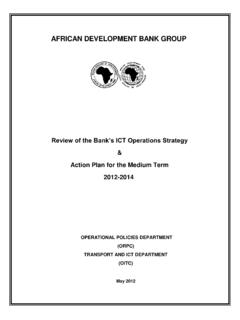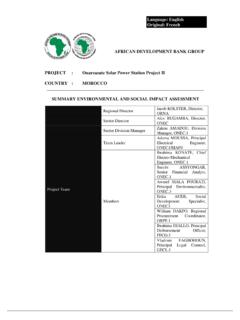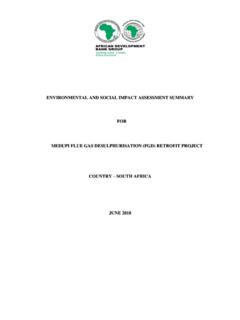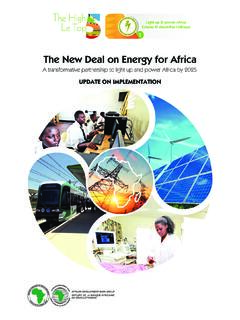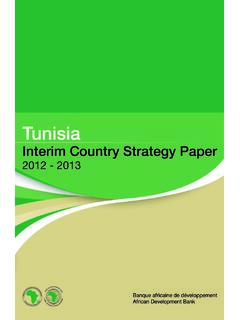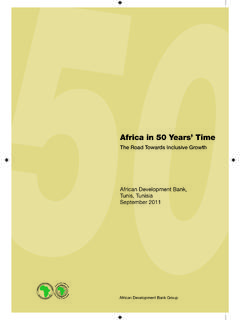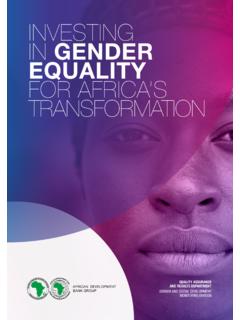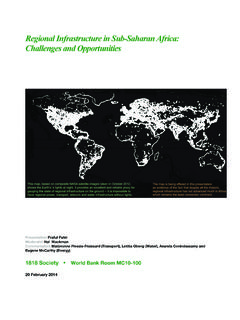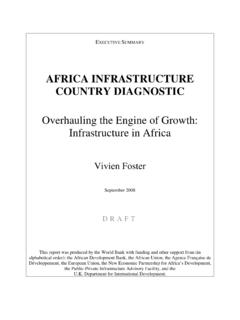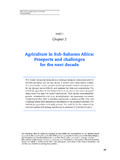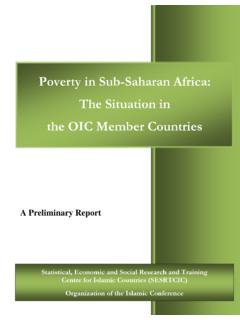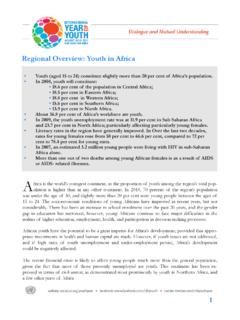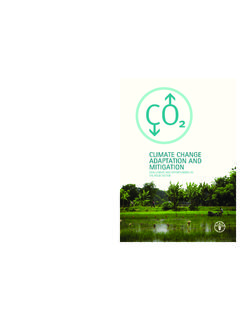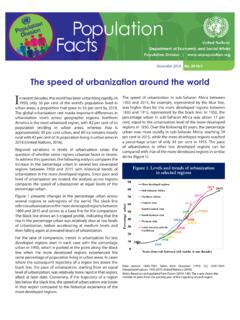Transcription of West Africa Economic Outlook 2018 - afdb.org
1 West AfricaEconomicOutlook2018 Macroeconomicdevelopments andpoverty, inequality,and employmentLabor marketsand jobsWest AfricaEconomicOutlook2018 The opinions expressed and arguments employed herein do not necessarily reflect the official views of the African Development Bank, its Boards of Directors, or the countries they represent. This document, as well as any data and maps included, are without prejudice to the status of or sovereignty over any territory, to the delimitation of international frontiers and boundaries, and to the name of any territory, city, or design by the African Development Bank based on images from African Development Bank 2018 ISBN 978-9938-882-66-7 (print) ISBN 978-9938-882-67-4 (electronic)You may copy, download, or print this material for your own use, and you may include excerpts from this publication in your own documents, presentations, blogs, websites, and teaching materials, as long as the African Development Bank is suitably acknowledged as the source and copyright vExecutive summary 1 Part I The West African economy 3 GDP growth and key drivers 3 Macroeconomic stability 5 Poverty, inequality, and employment 9 Emerging policy issues in West Africa 14 Part II Labor markets and jobs in West Africa 17 Labor force participation, unemployment.
2 And vulnerability in West Africa 17A dual and essentially informal labor market 28 The business environment and demand for labor 31 Policy responses to unemployment and underemployment 35 Notes 38 References 39 Boxes1 Official employment statistics: Use them with caution 202 Informality and exclusion: Female entrepreneurship in Central Africa 37 Figures1 Real GDP growth rate, 2016 19 42 Sectoral share of GDP, 2000 17, and by country, 2017 53 Growth drivers in West Africa , 2015 64 Growth in key West African Economic drivers, 2016 18 65 West African inflation rate, 2014 19 76 West African countries terms of trade, 2013 16 87 West African macroeconomic stability and Economic growth, 2013 20 88 Public expenditure as a share of GDP in West Africa , 2015 18 99 Budget deficit as a share of GDP in African regions, 2014 19 1010 Domestic resource mobilization, 2010 15 10 CONTENTS iiiiv CONTENTS11 Debt dynamics in West Africa , 2015 18 1112 Poverty incidence and the poverty gap in West Africa .
3 1981 2013 1113 Income inequality in West African countries 1214 Inequality in West Africa , 1991 2015 1315 West African employment by sector, 2008 14 1316 Labor productivity growth, 2005 16 1417 GDP per capita, 1990 2016 1818 Working-age population and labor force participation in West African countries, 1990 2014 1919 Time spent collecting water by women and men 2220 Time spent collecting fuelwood by women and men 2221 Unemployment rates, world regions, 2000 16 2322 Vulnerable jobs in West Africa , 2000 16 2323 Share of youth in total employment, 2000 16 2424 Share of women in total employment, 2000 16 2625 Gender equality in employment 2726 Gender equality in access to and ownership of land 2827 Employment by public, formal private, and informal sectors in seven West African Economic capitals 3028 Workers in formal employment in Senegal, 1980 2012 3129 Employees in informal enterprises earning less than minimum wage in seven West African Economic capitals 3230 Lack of basic services in informal enterprises in seven West African Economic capitals 3231 Lack of benefits for informal enterprise employees in seven West African Economic capitals 3332 Number of taxes, and time spent declaring and paying taxes 3433 Labor market rigidity in West African countries 3534 Access to electricity and per capita GDP in West Africa and comparator countries 36 Tables1 Sum of unemployed and vulnerable jobs in West Africa , 2000 16 242 People ages 15 24 not in education, employment, or training (NEET) as a proportion of total youth by sex in West African countries, 2005 and 2010 253 People ages 15 24 not in education, employment, or training (NEET)
4 As a proportion of total youth by locale in West African countries, 2005 and 2010 264 Women s share of the population in vulnerable employment, 2000 16 275 Underemployment in Benin, 2007 11, by sector and industry 296 Informal enterprises and percent of employed women and migrants in seven Economic capitals 307 Wages of employees according to firm status 31 ABBREVIATIONSAfDB African Development BankAFRISTAT L Observatoire Economique et Statistique d Afrique Subsaharienne ( Economic and Statistical Observatory of Sub- saharan Africa )CFA Communaut financi re d Afrique francECCAS Economic Community of Central African StatesECOWAS Economic Community of West African StatesGDP Gross domestic productICLS International Conference of Labor StatisticiansICT Information and communications technologyIIAG Ibrahim Index of African GovernanceILO International Labour OrganizationNEET Not in education, employment, or trainingOECD Organization for Economic Co-operation and DevelopmentPNDES Plan National de D veloppement conomique et Social (Burkina Faso)SADC Southern African Development CommunitySSA Sub- saharan AfricaTOT Terms of tradeUNDP United Nations Development ProgrammeVSE Very small enterpriseWAEMU West African Economic and Monetary Union vThe service sector s share in the economy is the largest in most countries, and man-ufacturing s share is the smallest in all of them.
5 Demand in the economies comes primarily 70 percent on average from pri-vate consumption, but gross capital forma-tion is expected to be the fastest growing area of demand in the next couple of reduce vulnerability to external shocks threatened by the dependence of several economies, especially Nigeria, on oil or other mineral extraction, West Africa must increase domestic input into its products through manufacturing, especially processing miner-als and agricultural has run in double digits since 2015, hindering growth. Budget deficits have been stable and lower than Africa s average, but government revenues have depended largely on the category other taxes and nontax revenues without much attention to direct, indirect, and trade taxes. The large informal economy has been neglected as a government revenue source. External debt grew as Economic growth fell during the 2015 16 slump in global commodity prices.
6 But for 2018, a decline in the debt-to-GDP ratio is projected due to improved commodity prices and increased global is high, with 43 percent of the population below the international $ per day poverty line in 2013 (the most recent estimate). Civil strife in Liberia and elsewhere drove this number up. Income inequality stayed high even during Economic growth up to 2016. Reducing inequality will require structural Economic transformation moving labor from low-skilled parts of the economy to high-skilled, higher-paying Africa s labor force participation rate is high and its unemployment rate is low. Sig-nificant problems in the ways these numbers are collected lead to underestimates of wom-en s Economic contributions and to difficul-ties in understanding youth labor market is almost entirely infor-mal. In one estimate for Senegal, only percent of jobs were formal. Virtually all agricultural labor is informal.
7 Much informal work is self-employment (80 percent in Africa overall). Informal workers are poorly paid, and many receive wages below the poverty line. Formal sector wages are much higher and tend to follow public sector , underemployment, job pre-cariousness, and income inequality affect women more than men. Women s situation is Average GDP growth in West Africa stalled in 2016, after several strong years, to percent. It rebounded in 2017 to percent, and was projected to rise to percent in 2018 and percent in 2019. Countries performance varied, but because Nigeria contributes about 70 percent of regional GDP, its patterns largely shape regional SUMMARY 12 ExECUTIVE SUMMARY compounded by unequal access to and owner-ship of business environment shapes the formal sector, which creates few decent jobs. In the normal course of structural transformation, labor shifts from agriculture to manufacturing to serv-ices.
8 That transition has stalled in West Africa due to customs problems, unavailability of finance, high taxes and heavy burdens of tax accounting, rigid regulation by a low-quality bureaucracy, and inadequate energy and transport infrastructure. The consequence is an atrophying formal sector and a booming informal key upcoming development challenges in West Africa include: (1) improving macroeconomic stability, (2) supporting structural reforms, (3) devel-oping industry, (4) increasing competitiveness (5) supporting agricultural development, (6) build-ing public sector institutions, (7) managing mineral resources better, (8) enhancing regional integra-tion, (9) supporting fragile states, (10) empower-ing youth through jobs, (11) mobilizing domestic revenue, and (12) strengthening national statistical responses to unemployment and under-employment include supporting very small enter-prises, for example through targeted workshops and coaching, and creating business incuba-tors providing physical facilities, consulting, and development tools for emerging businesses.
9 Policy should also promote industries that rely on unskilled labor, such as light manufacturing and processing agricultural, horticultural, and fishery WEST AFRICAN ECONOMYGDP GROWTH AND KEY DRIVERSB etween 2012 and 2015, many West Afri-can countries experienced high growth. But in 2016, growth slowed, averaging about percent (figure 1). The 2016 slowdown was widespread, with Nigeria and Liberia recording negative growth, though some countries had very high growth, such as C te d Ivoire at almost 9 percent. The slowdown in Nigeria, because of that economy s size relative to the region, meant a considerable decline in West Africa s 2017, regional growth rebounded, averaging about percent. In 2018, it is projected to increase to percent, and in 2019 to percent (see figure 1). Nigeria s projected performance drives these trends, too. The other major economies in the region, C te d Ivoire and Ghana (in that order), together contributed about 11 percent of the total regional GDP in 2017, and their projected growth in 2018 19 will reinforce Nigeria s The positive Outlook for the region is premised on oil price recovery and oil pro-duction increases for Nigeria and Ghana, and on strong agricultural of GDP growth by sectorServices are the dominant sector in West Africa , since in the key countries, services contribute most to GDP (in Liberia and Sierra Leone, however, agriculture remains dom-inant) (figure 2).
10 Across all countries in the region, manufacturing s share in GDP is the lowest of any sector. Manufacturing s highest share in the region is in C te d Ivoire about 18 percent of GDP in 2017. In most West Afri-can countries, manufacturing is confined to light industry processing primary products and producing consumer of which sectors and subsec-tors will drive their economies vary from one country to another. In Burkina Faso, man-ufacturing and industry will be the growth engine, given the sustained pace of the Plan National de D veloppement conomique et Social (PNDES) 2016 20, while agriculture, which has received recent investment, will be in second place. But in Cape Verde, tour-ism, transport, manufacturing, and hotel and catering are expected to be the most impor-tant in 2018. In projections for C te d Ivoire over 2018 20, manufacturing and services drive Economic West Africa Economic Outlook presents a comprehensive Economic analysis of the 16 countries in this region, focusing on growth, macroeconomic stability and employment, structural change, and poverty reduction.
